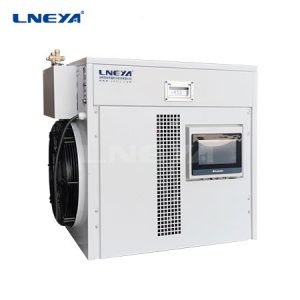10 Ton Chiller for Sale
The exhaust temperature of the compressor in the 10 ton chiller determines whether the operation of the equipment is stable and efficient. The compressor is prone to the problem of excessively high exhaust temperature. Once this happens, it is easy to make the pressure of the 10 ton chiller too high. High and high temperatures, high loads, reduced compressor efficiency, and various other problems. So what is the reason for the high exhaust temperature of the 10 ton chiller?
1. The compression ratio is too high
The exhaust temperature is greatly affected by the compression ratio, the larger the compression ratio, the higher the exhaust temperature. Reducing the compression ratio can significantly reduce the exhaust temperature, and the specific methods include increasing the suction pressure and reducing the exhaust pressure.
Suction pressure is determined by evaporating pressure and suction line resistance. Increasing the evaporation temperature can effectively increase the suction pressure and rapidly reduce the compression ratio, thereby reducing the exhaust temperature. Reducing the resistance of the return air pipeline can also increase the return air pressure. The specific methods include timely replacement of the dirty and clogged return air filter, and reducing the length of the evaporation tube and the return air line as much as possible.
In addition, insufficient refrigerant is also a factor for low suction pressure. After the refrigerant leaks, it must be replenished in time.
The main reason for the exhaust pressure being too high is that the condensing pressure is too high. Insufficient heat dissipation area of the condenser, fouling, insufficient cooling air volume or water volume, too high cooling water or air temperature, etc. can lead to excessively high condensing pressure. It is very important to select a suitable condensation area and maintain sufficient cooling medium flow.
2. High return air temperature
The return air temperature is relative to the evaporation temperature. In order to prevent liquid return, the general return gas pipeline requires a return gas superheat of 20°C. If the return air pipeline is not well insulated, the superheat will far exceed 20°C.
The higher the return air temperature, the higher the cylinder suction temperature and exhaust temperature. For every 1°C increase in the return air temperature, the exhaust temperature will increase by 1 to 1.3°C.
3. Motor heating
For the return air-cooled refrigeration compressor, the refrigerant vapor is heated by the motor when it flows through the motor cavity, and the cylinder suction temperature is raised again. The heat generated by the motor is affected by power and efficiency, while the power consumption is closely related to displacement, volumetric efficiency, working conditions, and frictional resistance.

저온 냉각기(수냉식 및 공냉식)
온도 제어 범위: -150°C ~ -5°C
당사는 -150°C의 낮은 온도 제어 범위를 갖춘 저온 냉각기 생산을 전문으로 하며, 다양한 산업의 냉장 요구 사항을 충족할 수 있습니다.
| 온도 범위 | -25°C ~ -5°C 시리즈 | -45°C ~ -10°C 시리즈 | -60°C ~ -10°C 시리즈 | -80°C ~ -30°C 시리즈 | -110°C ~ -50°C 시리즈 |
| 냉각 용량 | 최대 360kW | 최대 360kW | 최대 360kW | 최대 270kW | 최대 180kW |

재순환 냉각기 (수냉식 및 공냉식)
온도 제어 범위: -120°C ~ +30°C
당사의 재순환 냉각기는 저온 냉동 기술을 채택하고 온도가 -120℃까지 낮으며 다양한 액세서리를 사용자 정의 할 수 있습니다.
| 온도 범위 | -25°C ~ +30°C 시리즈 | -45°C ~ +30°C 시리즈 | -60°C ~ -20°C 시리즈 | -80°C ~ -20°C 시리즈 | -120°C ~ -70°C 시리즈 |
| 냉각 용량 | 최대 38kW | 최대 12kW | 최대 7.2kW | 최대 7.2kW | 최대 8.6kW |

실온 냉각기/소형 냉각기
온도 제어 범위: +5°C ~ +50°C
이 냉각기는 다양한 산업 및 실험실에서 널리 사용될 수 있으며 맞춤형 설계를 지원합니다.
| 온도 범위 | -18°C ~ +30°C | +5°C ~ +35°C 시리즈 |
| 냉각 용량 | 최대 0.9kW | 최대 50kW |

직접 냉각식 냉동 장비
온도 제어 범위: -120°C ~ -10°C
열 교환 면적이 작고 열 교환이 큰 장소에 적합합니다.
| 온도 범위 | -40°C ~ -10°C | -80°C ~ -35°C | -120°C ~ -90°C |
| 압축기 전력 | 최대 8HP | 최대 8HP*2 | 최대 45HP*3 |

직접 냉각식 초저온 냉각기
온도 제어 범위: -150°C ~ -110°C
비즈니스를 위한 맞춤형 솔루션.
| 온도 범위 | -150°C ~ -110°C |
| 냉각 용량 | 최대 11kW |

스크류 칠러
저온 스크류 냉각기 및 실온 스크류 냉각기
비즈니스를 위한 맞춤형 솔루션.
| 온도 범위 | +5°C ~ +30°C | +5°C ~ +30°C | +5°C ~ +30°C | +5°C ~ +30°C | -25°C ~ +5°C | -25°C ~ +5°C |
| 냉각 용량 | 최대 1027kW(단일 컴프레서) | 최대 2134kW(듀얼 컴프레서) | 최대 934kW(단일 컴프레서) | 최대 1940kW(듀얼 컴프레서) | 최대 467kW(단일 컴프레서) | 최대 497kW(단일 컴프레서) |
 LNEYA
LNEYA
 简体中文
简体中文


















































































